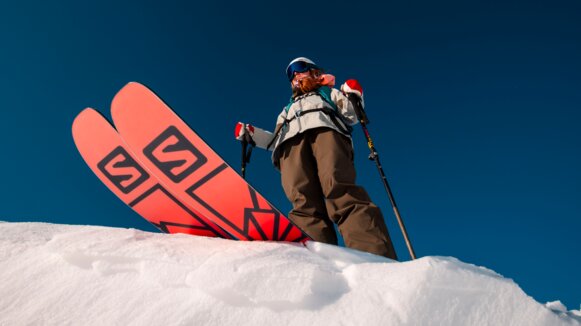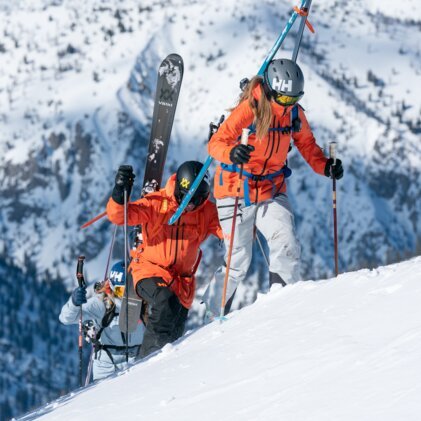
Every ski outfit is only worth half as much without them: perfectly fitting ski trousers. They keep you warm and dry and also offer protection from the elements. And to be honest: nobody wants to end their day of skiing early because of a wet bottom or cold legs, do they?
But what makes the perfect ski trousers? How to choose the perfect ski trousers when buying the right gear? To make it easier for you we have put together some tips for buying ski trousers together with the professionals from Salomon.
Ski pants, snow bib trousers and many more. What types of ski trousers are there?
You may be a little confused right now: trousers or ski pants, salopettes, snow bib trousers, ski suit – what do I actually need? In reality, the matter is quite simple, and the terms can be summarised in three patterns:
- snow trousers or ski pants reach up to the waist,
- snow bib trousers and salopettes are cut higher and have straps,
- and ski suits are a ski jacket and ski trousers in one.
Each of these variants has its advantages and disadvantages. "Simple" snow trousers are good all-rounders and can be worn for a day on the slopes without any problems. In deep snow without an additional snow guard in the jacket, however, it can happen that at some point there is more snow in your trousers and base layer than under your skis.
Snow bib trousers or salopettes are a good choice for off-piste skiing and exploring the backcountry, as they offer appropriate protection from swirling snow.
If it's really cold outside, a ski suit can be the right choice on the slope. However, when it gets warmer, it may take some time to take off a layer.
In addition to different patterns, there are also other material differences, which in turn affect performance. So it's worth thinking about what your perfect ski trousers need to be able to do before you buy them. Someone who goes ski touring all day and climbs peak after peak will attach great importance to breathability. Someone else will prefer a very warm pair of ski trousers because they'll be making run after run on the slopes. Let's take a look at the differences:
Hard shell trousers
- welded or glued seams
- excellent protection from wind and weather
- waterproof, windproof and breathable
- ideal in wet conditions
Softshell trousers
- great wearing comfort and good mobility
- more flexible than hardshell trousers
- very breathable
- ideal for park & pipe
Insulated ski trousers
- waterproof outer layer
- excellent insulation values
- ideal for very cold days
Are there differences between ski trousers for men, women and children?
Yes, there are indeed differences between the models for men and women. However, these are not just different colour combinations, but primarily cuts that are adapted to the anatomy of men and women. While men usually have wider thighs, women have a wider pelvis. Both are taken into account during development and are reflected in the final design and fit. However, there are no significant differences in terms of the technologies and materials used.
There are also other differences in trousers for children: the skiing trousers are a little more robust. As children sweat less than adults, more emphasis is placed on insulation and sturdy materials during development.
What requirements should a good pair of ski trousers fulfil?
If you're going to spend money on the perfect ski trousers, they should fulfil all your requirements – whether hard or soft shell. You should pay attention to the following aspects when buying:
Water resistance based on the water column
It goes without saying that your ski trousers should be waterproof. After all, they should protect you from rain and snow so that your base layer and legs stay dry and don't cool down.
The waterproofness of skiing trousers is measured using the water column. The value shown indicates how much water pressure from the outside the fabric can withstand before it absorbs moisture. The higher the column (in millimetres), the more waterproof your ski trousers are.
- low water resistance (5.001 mm – 10.000 mm): for average snowfall and light rain
- moderate waterproofness (1.001 mm – 15.000 mm): for moderate snowfall and light rain
- high waterproofness (15.001 mm – 20.000 mm): for heavy, wet snow and rain
- very high waterproofness (>20.001 mm): for extensive snowfall and moderate rain
Our product tip for waterproof ski trousers: the EDGE PANT M from Salomon.
How to choose the breathability of ski pants based on the MVTR value
As we all know, you can work up quite a sweat when skiing and snowboarding. That's why it's all the more important that your ski trousers have adequate breathability on top of being insulated. The more intense the activity, the faster and the more moisture needs to be actively transported away from the skin.
The moisture transport functionality of a pair of ski trousers is specified in grams and determined on the basis of the MVTR value ("Moisture Vapour Transmission Rate"):
- very low breathability (< 5.000 g): sweat cannot evaporate under moderate to heavy loads
- low breathability (5.001 g – 10.000 g): for low to moderate activity and short intensive phases
- moderate breathability (10.001 g – 15.000 g): for moderate activity with longer intensive phases
- high breathability (15,.01 g – 20.000 g): keeps you dry all day long
- very high breathability (>20.001 g): for a whole day of intensive activity
The materials used are responsible for actively transporting moisture between the inside and outside of a pair of ski trousers. You may have heard the term membrane before. First of all, a membrane is just a permeable layer. The two most common fabrics are:
- GoreTex®: These are called microporous membranes. If the temperature rises on the inside, e.g. due to rising body temperature during sport, pressure builds up due to the temperature difference between the inside of the trousers and the outside temperature. The moisture is then forced outwards through the membrane. However, water droplets in the form of rain and snow cannot get in.
- Sympatex: These are known as non-porous membranes. In contrast to the GoreTex principle, which requires temperature differences, non-porous textiles have a water-attracting material layer on the inside and a water-repellent layer on the outside. The effectiveness of moisture transport is therefore not linked to a temperature difference and happens automatically.
Both membranes have their advantages and disadvantages. It is therefore best to consider in advance which requirements the trousers need to fulfil, and which material is the most effective for your purposes.
Comfy warmth through insulation
Whether you're out on the slopes, in the park or in the backcountry– your ski trousers should keep you warm. Let's take a look at the different types of insulation:
Ski trousers without insulation (softshell)
- optimum freedom of movement
- little warmth
Lightly warming ski trousers
- lined or with light insulation
- particularly suitable for warmer days
Insulated ski trousers
- for "normal" winter days
- ideal in combination with a breathable base layer
Warm ski trousers
- with down, artificial down or synthetic insulation
Extra warm ski trousers
- with insulation and heat properties
- for very cold days
Our product tip for warm ski trousers: The BRILLANT PANT M from Salomon.
Additional features
The selection of different styles, technologies and fabrics is also huge for ski trousers. Many products have integrated additional features:
- gaiters
- reinforced cuffs
- ventilation
- pockets
- welded seams
- zips
- knee darts
- Recco reflectors
Some trousers also have reinforced material at the end of the waistband, which has been integrated to protect against the sharp edges of the skis.
What size should my trousers for skiing be?
As you will be moving around a lot in your ski trousers, it is important that they have the right fit. Therefore, choose trousers that meet the following criteria:
- Freedom of movement: The trousers should fit your movement profile. For example, if you want to go ski touring and spend time off-piste, your ski trousers should not restrict your movements, even when you are walking long distances.
- Waist size: Choose a size larger for the waist size than for your normal trousers! After all, your ski trousers should also be comfortable to wear with a base layer underneath.
- Trouser length: When buying ski trousers, you should also choose a slightly longer model than usual, as you have to take your ski boots into account.
Some ski trousers also have integrated gaiters that prevent snow from getting in if you want to embark on your next backcountry adventure.
Which functional underwear is best to wear under my ski trousers?
You've probably already heard of the onion look. This also applies to your lower body. In other words, it's best to wear functional underwear as a base layer under your ski trousers. Among other things, it is responsible for moisture transport, e.g. by absorbing sweat and passing it on to the next layer. This keeps your skin dry and, depending on the material, the layer also keeps you warm.
In spring or when temperatures are mild, you can get by without it, but in the middle of winter, when you get your skis out, you can wear something really warm, for example a merino wool base layer.
Frequently asked questions about the perfect ski trousers:
What should I look for when buying ski trousers?
The perfect ski trousers have to meet your own requirements. Waterproofing and breathability are two of the most important factors. Depending on whether you are looking for ski trousers for powder skiing, the park, the slopes or ski touring, both the material and the fit can vary.
Are softshell ski trousers good?
Softshell ski trousers can be your ideal winter sports companion. They are perfect for warm days on the mountain or for ski touring. The flexibility of the material allows plenty of freedom of movement, making it possible to take long steps in a variety of terrain. They are also very breathable. Softshell trousers are especially recommended for ski touring when you sweat a lot. They usually have ventilation slits that can be zipped open during a tour.
What should I wear under ski trousers?
The so-called onion principle – or just layering – also applies to ski trousers. However, unlike the upper body, you don’t wear any mid layer under ski trousers. A base layer is usually enough to ensure the breathability you need. This allows moisture from your skin to be absorbed by the fabric above and evaporate through the ski trousers. If your legs still feel cold despite the base layer, consider ski underwear made of a different material or a warmer pair of ski pants.
When are hardshell trousers better?
Hardshell ski trousers are usually more durable and have a higher water column than softshell trousers. Especially in poor weather conditions, hardshell ski trousers offer better protection from the wet and cold.
INTERSPORT Rent Tip
You're not quite sure how to decide on the perfect pair of ski trousers? Then why not try out a few models first!
At INTERSPORT Rent you will find a large selection of high-quality trousers for men and women to rent, including many ski trousers from leading brands. Our RENTertainers on site will be happy to show you our top products and kit you out for your next day out!









